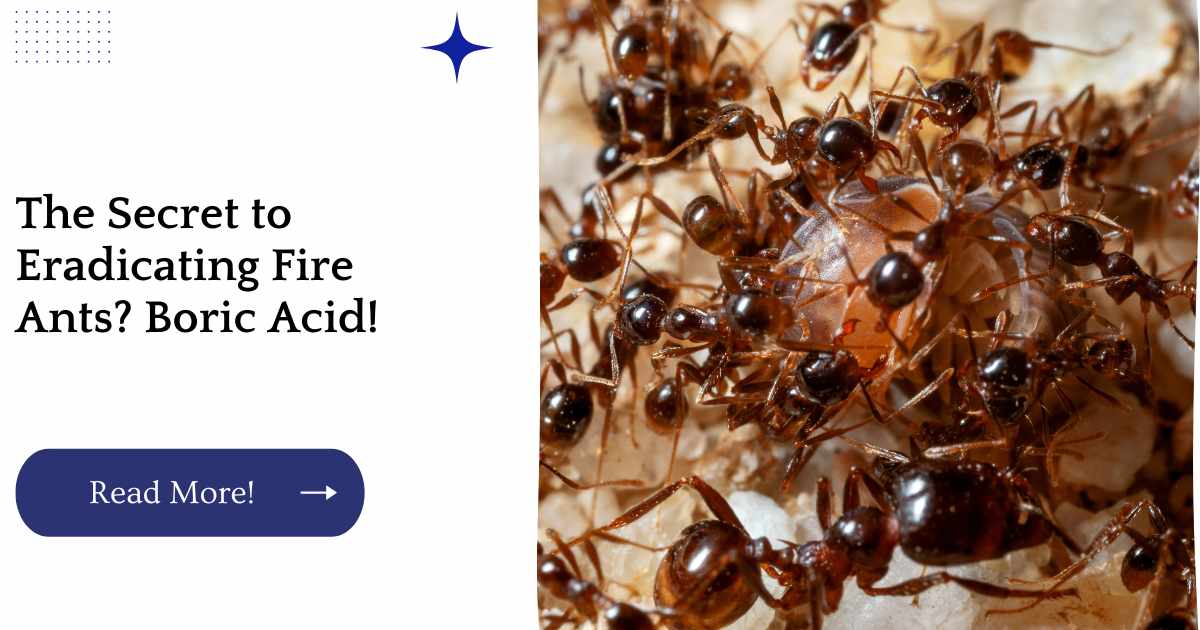Fire ants are one of the most dangerous pests in the world. When they invade your property, you need to take them seriously and eradicate them immediately.
However, self-treatment is not always easy and can lead to more problems if it’s not done correctly.
If you want the best chance at eliminating fire ants from your home or business, call a professional exterminator like myself who knows exactly how to get rid of these pests once and for all!
| Takeaways |
|---|
| Boric acid is an effective and natural solution for eradicating fire ants. |
| Proper application is key to achieving success with boric acid. |
| Boric acid should be used with caution around kids and pets. |
| Borax, a chemical compound similar to boric acid, can also be used to eliminate fire ants. |
| Boric acid can be used to control other pests, such as cockroaches and silverfish. |
Step 1: Find the Fire Ant Nest
Once you know what to look for, finding the nest is easy. Fire ants are social insects who build mounds that can reach up to 4 inches high and have a smooth surface.
These mounds are usually located at or near the base of a tree, shrub or grassy area, so if you see areas with tiny piles of soil (about the size of a quarter), those could be fire ant mounds. If you find some that match this description, use your shovel to dig down into it until you see a tunnel leading underground.
It’s possible that there will be no tunnels to find that just means the queen isn’t down there! However, if she is in residence and has already laid eggs by this point in time which she probably has you should definitely keep on digging until her chamber has been found; otherwise all your work will have been for nothing!
If you’re tired of fire ants ruining your yard, it’s time to take action with the natural power of boric acid. Learn more about how to use boric acid to eradicate fire ants once and for all.
Step 2: Find The Best Location to Pour the Boric Acid
If you’ve found a fire ant mound and are ready to pour your boric acid, it’s important to know the right conditions.
Here’s a quick list of things to watch out for:
- Don’t pour boric acid on a hot day. This will make ants run away from the mound rather than towards it, making your job harder.
- Don’t pour boric acid on a windy day. The wind will blow away both the powder and any remaining ants before they can get into their holes and take it down with them!
- Don’t pour boric acid when it’s raining or too cold out – unless you want dead ants everywhere!
If you’re looking for a natural solution to eliminate fire ants from your yard, borax may be the answer. Explore our guide on using borax to naturally eliminate fire ants for a safer and effective approach to pest control
Step 3: Add Moisture to the Boric Acid
- Add Moisture to the Boric Acid
- Pour about 1/4 cup of boric acid into a spray bottle, then fill with water.
- Use approximately 50% water, which means that you can add up to 3 tablespoons of boric acid.
- Screw on the top and shake well to combine.
Step 4: Take Precautions When Handling Boric Acid
- Wear gloves and a dust mask.
- Wear long sleeves and pants, as boric acid can irritate the skin and eyes.
- Avoid breathing in dust while applying it, as this can lead to respiratory illnesses like asthma or even cancer.
Getting rid of fire ants can be a challenge, but with the right approach, it’s possible to eliminate these pests for good. Our guide to effectively using boric acid can help you achieve a fire ant-free lawn.
Step 5: Pour Onto Mound
Pour the boric acid onto the top of the mound, but be careful not to get it on your skin, in your eyes or mouth, or on clothes. This might take several repetitions until you have successfully killed all of the ants.
Step 6: Repeat Application If Necessary
If you see the ants returning, repeat this process. Repeat it as many times as necessary until the fire ants are gone.
If you don’t see an increase in activity, then you can stop applying boric acid and move on to other methods of getting rid of these pests.
Are you struggling to get rid of fire ants and tired of applying ineffective treatments? Look no further than our comprehensive guide on using boric acid to eliminate fire ants. Say goodbye to fire ants for good with this powerful solution
Step 7: Prevent Boric Acid From Washing Away
Once you’ve applied boric acid, you need to make sure it stays in place. For example, if you were using a brush or wet cloth to apply it, then use a dry cloth or paper towel to wipe off excess residue.
This will prevent the ants from being able to pick up any trace amounts of boric acid on their feet and bringing it back home with them.
Another way to prevent the ant colony from picking up any extra boric acid is by applying it through a sprayer or watering can.
Of course this method means that there won’t be much on each individual ant but since they are walking around over an area where they have been sprayed with BoraCare®, there has been enough exposure for them all!
If your yard is really big and there aren’t many weeds in between patches of grass, then another option would be spraying away from where weeding will occur so that none gets into those areas when working more closely later on down the road after all ants are gone completely (which should take about two weeks).
Fire ants are a nuisance, but you don’t have to resort to harsh chemicals to eliminate them. Discover how boric acid can provide a natural and effective solution for your fire ant problems
Other Ways to Use Boric Acid Against Fire Ants
You can use boric acid in other ways to kill fire ants. For example, you can mix it with sugar water or dish soap and create a spray that will kill the ants on contact.
Conclusion
There you have it! If you follow these steps, you can get rid of fire ants once and for all. Remember that boric acid is toxic to humans and pets so wear protective clothing and don’t spill any on yourself.
Also, don’t pour out too much at a time or it may wash away before it gets absorbed by the mound—you want the ants to come into contact with as much powder as possible in order for this method to work well.
Finally, remember that this may take time so be patient with yourself as you go through each step of treating your yard!
Further Reading
Using Boric Acid to Control Fire Ants in Dallas: Learn how to safely use boric acid to eliminate fire ants in your yard with this guide from Romney Pest Control.
Eliminating Fire Ants with Boric Acid: Cantu Pest Control shares how boric acid works to combat fire ants and offers tips for application in this informative blog post.
Thwarting Ants Using Boric Acid-Based Bait: Discover a boric acid-based bait recipe for eliminating ants in this article from Espace pour la Vie.
FAQs
What is boric acid and how does it work against fire ants?
Boric acid is a naturally occurring compound that is poisonous to insects, including fire ants. It works by interfering with their digestive system and causing dehydration.
Is boric acid harmful to pets and humans?
While boric acid can be harmful if ingested in large quantities, it is generally considered safe for humans and pets when used as directed. However, it’s important to keep it out of reach of children and pets and to follow all application instructions carefully.
Can I use boric acid to eliminate fire ants inside my home?
Yes, boric acid can be effective for eliminating fire ants inside the home. However, care must be taken to avoid contact with food or surfaces where food is prepared or consumed.
How often do I need to reapply boric acid to eliminate fire ants?
The frequency of application depends on several factors, including the severity of the infestation and the amount of boric acid used. In general, it’s recommended to reapply boric acid every few months or as needed to keep fire ants at bay.
Can I use boric acid for other pest problems?
Yes, boric acid can be effective for controlling a variety of pests, including cockroaches and silverfish. However, it’s important to research the appropriate application methods for each pest and to use caution when applying in areas accessible to children and pets.

Hello! I’m Hellen James, and I write about how to keep pests from invading your home. For the last 10 years, I’ve been working in pest control and am excited to share my expertise with you!


